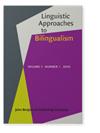The impact of language dominance on Russian-Hebrew bilingual children’s narrative production
IF 1.8
2区 文学
0 LANGUAGE & LINGUISTICS
引用次数: 2
Abstract
The study explores the effect of language dominance on microstructure, macrostructure, and Internal State Terms (ISTs) in narratives of Russian-Hebrew bilingual children and examines within-language and cross-language associations between narrative elements in two dominance groups. Narratives were collected from 38 Russian-Hebrew bilingual children aged 5;5–6;7 using the LITMUS-MAIN retelling procedures. The children were divided into L1-dominant (N = 19) and L2-dominant (N = 19) bilinguals based on performance on proficiency tests in L1/Russian and L2/Hebrew. The narratives were coded for microstructure measures: number of different words (NDW), total number of tokens (TNT), number of C-units (CUs), and Mean Length of C-unit (MLCU); and for macrostructure measures: Story Structure and Story Complexity. Ratios of IST tokens and types were calculated per C-unit. Children produced significantly higher NDW, TNT, and MLCU in L2/Hebrew than in L1/Russian. Scores on macrostructure measures and ratios of total ISTs were similar across languages. L1-dominant bilinguals demonstrated similarity between L1 and L2 for microstructure and IST types, whereas L2-dominant bilinguals produced more IST types in L2/Hebrew and had relatively few significant cross-language correlations. Findings for language dominance and cross-language differences are discussed for those narrative features which emerged as sensitive to these effects.语言优势对俄语-希伯来语双语儿童叙事生产的影响
本研究探讨了语言优势对俄-希伯来语双语儿童叙事中微观结构、宏观结构和内部状态术语的影响,并考察了两个优势群体中叙事元素之间的语言内和跨语言关联。从38名5岁的俄语-希伯来语双语儿童中收集叙述;5-6;7使用LITMUS-MAIN复述程序。儿童被分为L1显性组(N = 19) 和L2显性(N = 19) 基于母语/俄语和母语/希伯来语能力测试的双语者。叙述是根据微观结构测量进行编码的:不同单词的数量(NDW)、标记的总数(TNT)、C单元的数量(CU)和C单元的平均长度(MLCU);宏观结构测量:故事结构和故事复杂性。IST代币和类型的比率是按C单位计算的。儿童在二语/希伯来语中产生的NDW、TNT和MLCU明显高于一语/俄语。不同语言在宏观结构测量和总IST比率方面的得分相似。L1显性双语者在微观结构和IST类型方面表现出L1和L2之间的相似性,而L2显性双语者则在L2/希伯来语中产生了更多的IST类型,并且具有相对较少的显著跨语言相关性。针对那些对这些影响敏感的叙事特征,讨论了语言优势和跨语言差异的发现。
本文章由计算机程序翻译,如有差异,请以英文原文为准。
求助全文
约1分钟内获得全文
求助全文
来源期刊

Linguistic Approaches To Bilingualism
Social Sciences-Linguistics and Language
CiteScore
3.20
自引率
9.10%
发文量
24
期刊介绍:
LAB provides an outlet for cutting-edge, contemporary studies on bilingualism. LAB assumes a broad definition of bilingualism, including: adult L2 acquisition, simultaneous child bilingualism, child L2 acquisition, adult heritage speaker competence, L1 attrition in L2/Ln environments, and adult L3/Ln acquisition. LAB solicits high quality articles of original research assuming any cognitive science approach to understanding the mental representation of bilingual language competence and performance, including cognitive linguistics, emergentism/connectionism, generative theories, psycholinguistic and processing accounts, and covering typical and atypical populations.
 求助内容:
求助内容: 应助结果提醒方式:
应助结果提醒方式:


